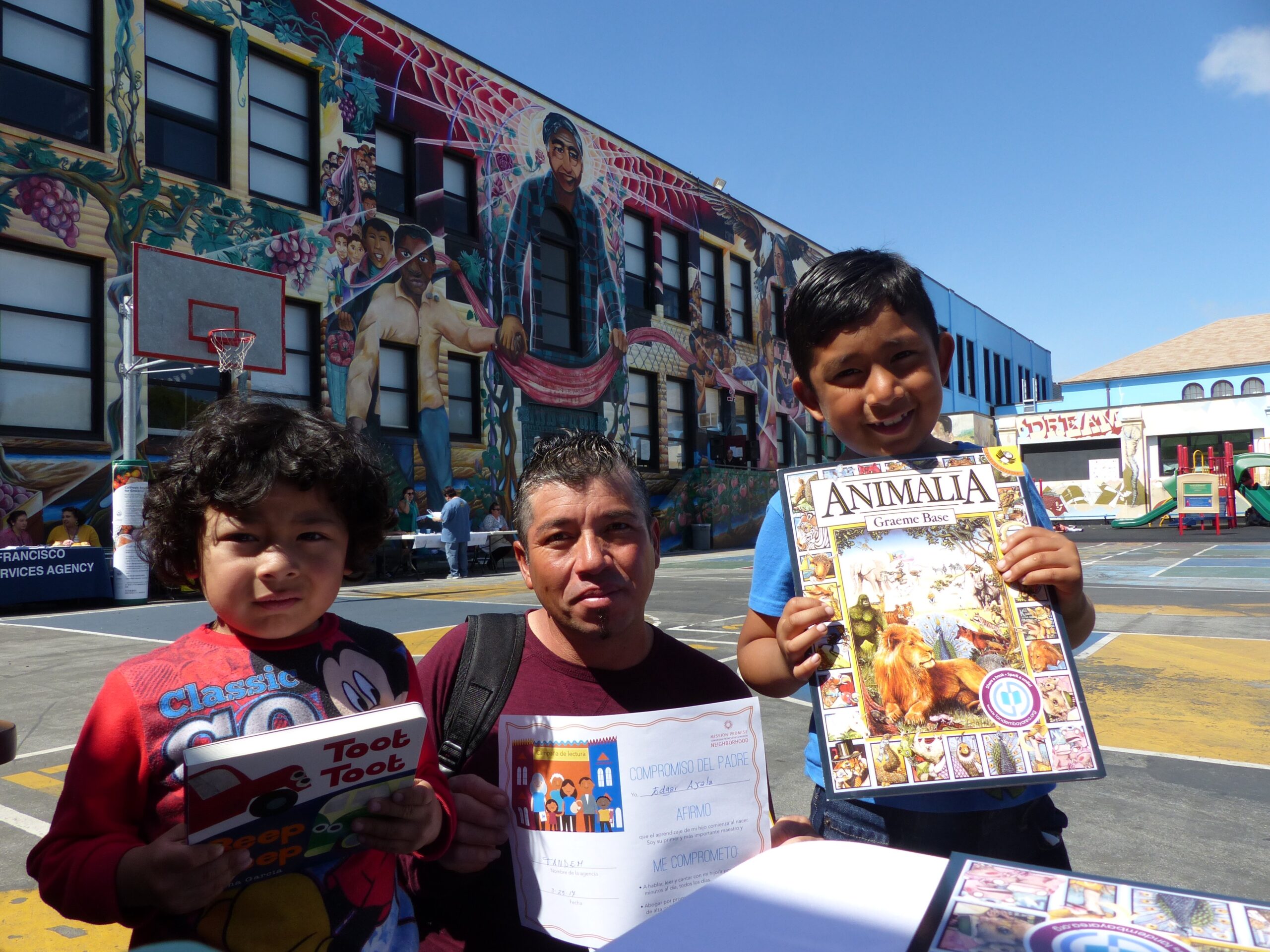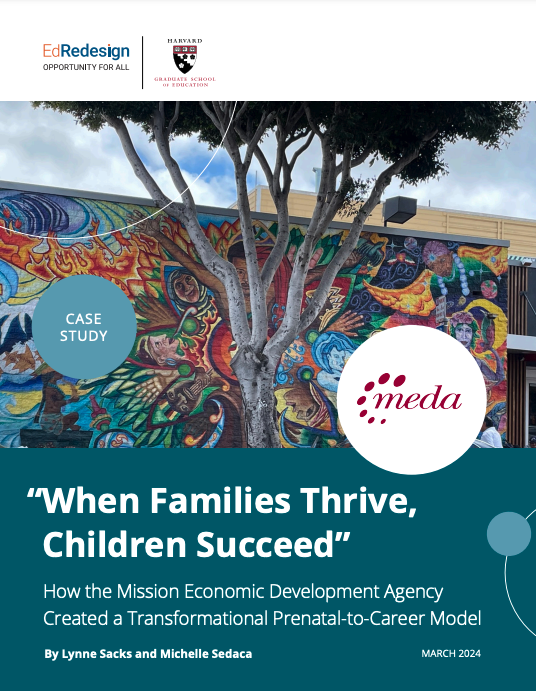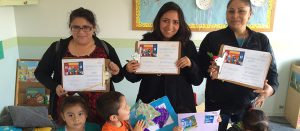[Click for English, which follows Spanish.]
Al regresar a sus puestos de trabajo en el verano de 2020, un grupo de maestras de educación de temprana edad en la Mission se vio ante un desafío que no habían vivido antes: decirle a los niños que no podían jugar juntos.
“Por el distanciamiento social fue un desafío, era bien complicado”, recuerda Irma Chereno, una de las educadoras de Good Samaritan Family Resource Center, un aliado educativo de Comunidad Promesa de la Mission que por más de 100 años apoya a las familias inmigrantes con la educación y cuidado de sus hijos más pequeños.
En los últimos 18 meses, las maestras de Good Samaritan han vivido un proceso transformativo en varios aspectos de sus vidas para poder cumplir con su misión dentro de una comunidad impactada desproporcionadamente por la pandemia del COVID-19. Las condiciones de vida de las familias y el protagonismo de los inmigrantes en la fuerza laboral resaltan aún más el trabajo de este tipo de organizaciones.
“Fue algo bastante complejo para maestras, para las familias, para los niños, sumado al riesgo que estábamos tomando al reintegrarnos acá cuando el COVID estaba en su peor etapa”, dice Chereno, quien fue una de las primeras maestras en retomar el trabajo presencial en Good Samaritan después de cerca de dos meses de cierres obligatorios en San Francisco y educación virtual.
La pandemia representó cambios en la forma de trabajar para Good Samaritan, pero nunca modificó su misión de “ayudar a las familias vulnerables, incluidas las familias inmigrantes, a acceder a los servicios necesarios, desarrollar la autosuficiencia y participar plenamente como miembros de la comunidad de San Francisco”. La demanda por sus servicios se hizo mayor a medida que las necesidades de las familias se apilaban. Durante el encierro se hizo obligatorio recurrir a la tecnología para mantener el contacto con los miembros de la comunidad.
“La tarea principal fue la comunicación ya que muchas familias no tenían acceso a internet, o no tenían computadoras”, explica Angélica Torres Castillo, educadora líder de niños entre 3 y 4 años en Good Samaritan. “Las maestras empezamos a reunirnos con programas como WhatsApp, ya que muchas familias estaban familiarizadas con eso, y también usando el Zoom”.
Pero comprender el mundo virtual fue apenas una parte de los cambios. La operación presencial en la sede de Good Samaritan en Potrero Avenue tuvo que ser modificada para poder servir a la comunidad para poder garantizar la seguridad de niños, familias, maestros y otros trabajadores esenciales que hacen parte de la organización. Hasta el día de hoy hay protocolos estrictos de limpieza, distanciamiento social y uso de mascarillas.
“Cuando las circunstancias parecían más extremas, nuestros maestros respondieron a nuestro llamado para satisfacer las necesidades de los niños más pequeños de nuestra comunidad,” dice Melissa Castillo, directora del Centro de Desarrollo Infantil de Good Samaritan. “Si bien reconocemos que la pandemia ha ampliado la brecha educativa y desafía el futuro de nuestros niños, nuestros maestros continúan brindando estabilidad y cuidado, y brindan entornos de aprendizaje enriquecedores en nuestro programa.”
Otra realidad, nuevos enfoques
Cumplir con su misión de servicio a la comunidad implicó sacrificios y esfuerzos en casa de los educadores, que, como el resto de la población, luchaban para proteger a sus familias.
“En casa puse desinfectantes en la puerta, al llegar me quitaba los zapatos y los desinfectaba; desinfectaba manijas porque tenía que cuidar a la familia”, recuerda Chereno, quien vive con dos adultos de 90 años.
Tanto rigor tenía un precio emocional. La protección llegaba a representar distancia de los seres queridos por más que se compartiera el mismo espacio.
“Me vi en el punto de no abrazar a mis padres”, dice Torres. “Fue un cambio fuerte, especialmente en lo emocional, pero teníamos que tener un sistema riguroso porque no sabíamos mucho sobre el virus”.
La nueva realidad impulsó a robustecer los servicios de Good Samaritan tanto para sus educadores como para miembros de la comunidad. En el último año se implementó un desarrollo profesional más sólido para los maestros, mientras que a las familias se les pudo proveer con alimentación y asistencia económica. En el campo de salud mental se trabajó con especialistas para dar un mejor respaldo a las familias.
“A medida que Good Samaritan comience a reinventar su modelo de prestación de servicios en la post-pandemia, las relaciones auténticas que los maestros han construido con los niños y los padres serán un modelo de cómo las comunidades se unen para apoyarse mutuamente y abogar por el cambio”, dice Ada Freund, gerente de aprendizaje de temprana edad de Comunidad Promesa de la Mission.
Un pueblo entero
A más de un año de pandemia, las maestras de Good Samaritan se movilizan inspiradas por las familias a las que sirven en tiempos en que se redoblan los esfuerzos. Su trabajo tiene otra dimensión como consecuencia de una mayor interacción con los miembros de la comunidad.
“Casi que nos convertimos en trabajadoras sociales”, dice Torres, quien pide mayor atención, inversión y reconocimiento a la labor de maestras de educación temprana. “También somos maestros, nos preparamos para esto, estamos enseñando”.
La multiplicación de los esfuerzos sirvió para renovar y reforzar los lazos de Good Samaritan con otras organizaciones. La estrecha colaboración ha sido fundamental para resolver el presente y decidir la hoja de ruta del futuro.
“Entendemos que realmente se necesita a todo un pueblo, y trabajamos en estrecha colaboración con socios de la comunidad para brindarles a los niños todas las oportunidades para que alcancen su máximo potencial”, dice Castillo. “Nuestro socio en alfabetización, Tandem, nos proporciona libros y acceso a materiales de alfabetización culturalmente diversos. Otros socios de Comunidad Promesa de la Mission nos ayudaron con cajas de alimentos, suministros de protección sanitaria y artículos de emergencia para las familias durante el pico de la crisis pandémica. Lo más importante es que todos aprendimos que somos más fuertes cuando todos trabajamos juntos”.
Good Samaritan: Pivoting to Best Educate Children and Serve the Community During a Pandemic
Upon returning to their Mission District job site in summer 2020, a group of early education teachers were faced with an unusual challenge: telling children they could no longer play together.
“Social distancing created a challenge. It was very complicated,” recalls Irma Chereno, one of the Early Child Educators (ECE) at Good Samaritan Family Resource Center, an organization that for over a century has supported immigrant families with the education of their young ones. Good Samaritan has also been a decade-long partner of the Mission Promise Neighborhood, a community anti-poverty education initiative for which MEDA is the lead agency.
In the last 18 months, Good Samaritan teachers have pivoted to support a community disproportionately impacted by the COVID-19 pandemic due to overcrowded living conditions of families coupled with the majority of Latino immigrants being frontline essential workers.
“The situation was quite complex for teachers, for families and for children, and this was all the riskier because we were reintegrating our programs when COVID-19 was at its peak,” says Chereno, who was one of the first teachers to resume face-to-face work at Good Samaritan after about two months of shelter-in-place and virtual education.
While the pandemic changed the way Good Samaritan operates, it never changed its mission “to help vulnerable families, including immigrant families, access needed services, develop self-sufficiency and participate fully as members of the San Francisco community.” The demand for their services grew as the urgent needs of families piled up. During confinement, technology became instrumental to maintaining contact with community members.
“The main task was communication since many families did not have access to the internet, or did not have computers,” explains Angélica Torres Castillo, a Master Teacher of 3- and 4-years-olds. “We began to meet through programs such as WhatsApp, since many families in our community use it, and also using Zoom.”
But understanding the virtual world was only part of the changes. The operations at Good Samaritan’s site on Potrero Avenue had to be modified to serve the community while ensuring the safety of children, families, teachers and other essential workers who are all integral parts of the organization. To this day, there are strict protocols for cleaning, social distancing and mask wearing.
“When circumstances looked most dire, our selfless teachers answered our call to meet the needs of our community’s youngest children,” says Melissa Castillo, Child Development Center Director at Good Samaritan. “While we recognize the pandemic has widened the educational gap and challenges the future for our children, we are proud that our teachers continue to provide stability and care, and always provide a nurturing learning environment.”
Another reality, new approaches
While trying to accomplish their mission with the children, ECE teachers navigated through a series of sacrifices and efforts at their own homes as they tried to protect their loved ones, just like the rest of their neighbors were doing.
“At home, I put disinfectants on the door. I would take off my shoes and disinfect them. I sanitized handles because I had to take care of the family,” recalls Chereno, who lives with a pair of 90-year-olds.
Such discipline took an emotional toll: Protection meant distancing from loved ones in the space they usually shared.
“At one point, I saw myself not hugging my parents,” says Torres. “It was a strong change, emotionally challenging, but we had to have a rigorous system because we didn’t know much about the virus at that time.”
The new reality prompted the strengthening of Good Samaritan’s services for its educators and community members. In the last year, stronger professional development was implemented for teachers, while families were provided with food and financial assistance. In terms of mental health, Good Samaritan worked with specialists to give better support to families.
“As Good Samaritan begins to reimagine their post-pandemic service delivery strategy, the authentic partnerships teachers have built with children and parents will be a model of how communities come together to support each other and advocate for change,” says Ada Freund, Mission Promise Neighborhood Early Learning Manager.
The future
A year and a half into the pandemic, Good Samaritan teachers continue to pivot, inspired by the families they serve in this time of a doubled effort by staff. Their work now offers a more intricate interaction with members of the community.
“We basically became social workers,” says Torres, who urges for more attention, investment and recognition of the work ECE teachers do. “We are also teachers, we have studied to be educators, we are teaching.”
This time of multiplying efforts and redefining roles for Good Samaritan has also been one to renew and strengthen ties with other community-based organizations. Close collaboration has been essential to resolving current challenges — and for drawing a roadmap for the future equitable recovery needed in the Mission.
“At Good Samaritan, we further understand that it really, really does take a village, and we work closely with community partners and supporters to provide children with every opportunity for them to achieve their full potential,” says Castillo. “For example, MPN literacy partner, Tandem, Partners in Early Learning, provides us with books and access to culturally diverse and language-appropriate literacy materials. Other MPN partners helped us with food boxes, PPE supplies and emergency essential goods for families during the height of the pandemic crisis. The most important lesson is that we are stronger when we all work together.”




 Story by
Story by  by Early Learning Manager Liz Cortez
by Early Learning Manager Liz Cortez by MEDA Director of Community Real Estate Karoleen Feng
by MEDA Director of Community Real Estate Karoleen Feng


